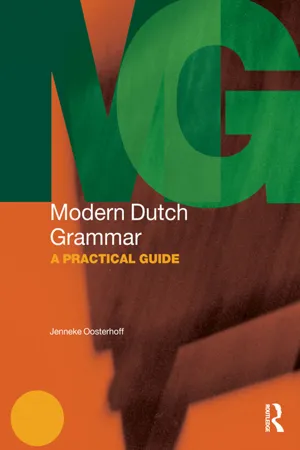![]()
Part I
Structures
![]()
A
Noun groups
![]()
1
Nouns
1.1 Articles and nouns
Dutch has two definite articles, de ‘the’ for masculine and feminine (or common) nouns, and het ‘the’ for neuter nouns. Examples are de tafel ‘the table,’ de stoel ‘the chair,’ and het bed ‘the bed.’ When we use indefinite nouns, we use een ‘a’ or no article. Examples are een huis ‘a house’ and melk ‘milk.’ Melk is an uncountable noun, and while all nouns, countable or uncountable, can appear with a definite article, the indefinite article een only appears with countable nouns in the singular. Uncountable indefinite nouns as well as countable indefinite nouns in the plural appear without article. All definite nouns in the plural appear with the article de. Examples:
General uses of the article
Indefinite articles are used to introduce a subject or object that is not known to the listener or to use nouns in a general, categorical or abstract meaning. Definite articles are used to talk about subjects and objects that are known to the listener (often as abstract concepts) or to further specify or qualify an indefinite noun that has been introduced. The examples show the similarity to English.
Ik heb een tafel gekocht. De tafel staat nu in de eetkamer.
I bought a table. The table is now in the dining room.
Ik wou melk in de koffie doen, maar de melk was zuur.
I wanted to put milk in my coffee, but the milk was sour.
Er ligt ijs op het water. Het ijs is nog niet dik genoeg om te schaatsen.
There is ice on the water. The ice is not yet thick enough to skate.
Een poes is minder werk dan een hond, want je hoeft hem niet uit te laten.
A cat is less work than a dog, because you don’t have to walk it.
De meeste mensen denken dat de gloeilamp door Edison werd uitgevonden.
Most people think the light bulb was invented by Edison.
De krant wordt ‘s morgens bezorgd.
The newspaper is delivered in the morning.
Names of people, countries and cities
These categories have no article, but take a definite article when a specific qualification or distinction is added. Note the difference in the following examples:
Mondriaan schilderde vooral abstracte schilderijen. Maar ken je de Mondriaan van de figuratieve schilderijen?
Mondriaan painted primarily abstract paintings. But do you know the Mondriaan of the figurative paintings?
Ik woon al heel lang in Amsterdam. Ik hield vooral van het Amsterdam van de 70er jaren. Het Amsterdam van nu vind ik vreselijk.
I have lived in Amsterdam for a long time. I loved the Amsterdam of the 1970s. I think today’s Amsterdam is terrible.
Names of languages
Similarly, names of languages that one knows, speaks, or learns do not take an article.
Peter spreekt goed Duits en Engels. Hij leert nu ook Frans.
Peter speaks German and English well. He is also learning French now.
However, when talking about a certain kind of a specific language, the indefinite article is added.
In Baden spreken ze een Duits dat ik niet versta.
In Baden, they speak a German that I don’t understand.
Note that contrary to English, in the following cases, the name of a language takes the definite article.
Karel heeft drie boeken in het Engels vertaald.
Carl has translated three books into English.
Annemarie bestudeert de geschiedenis van het Nederlands.
Annemarie is doing research on the history of Dutch.
Other cases in which Dutch often differs from English
There are some cases in which the use of the article differs from English. For example, when talking about one’s profession, function, or hobby, one’s affiliation with a country, a city, or a religion, we do not use the indefinite article.
Johan is advocaat.
John is a lawyer.
Stephan is Duitser.
Stephan is a German.
Veel kinderen willen brandweerman worden.
Many kids want to become a firefighter.
Hij is manager in een groot bedrijf.
He is a manager in a big company.
Karin en Minnie spelen piano.
Karin and Minnie play the piano.
Joop is lid van de tennisvereniging.
Joop is a member of the tennis club.
Professions, functions, nouns in a general meaning with the conjunction als (meaning ‘as a’) also do not take the indefinite...

